Abstract
Modern induction cookers have started to demand challenging features such as slim design, high power ratings, high performance, and silence. All those requirements are directly related to the power semiconductors used in power converters. Si (silicon)-based power semiconductors are not capable of answering those demands because of strict operating conditions, such as high ambient temperatures. Therefore, WBG (Wide Band Gap) power semiconductors have been getting attention. In this study, WBG power semiconductors will be compared with Si-based IGBT (Insulated Gate Bipolar Transistor) under different operating conditions. The best option to use WBG power semiconductors in modern induction cookers will be analyzed. The performance of a series-resonant half-bridge converter was evaluated under various operating conditions. Measurements were obtained from the real operating conditions of induction hobs. The switching frequency is changed from 20 kHz to 100 kHz, while the power rating is increased to 3.7 kW. In addition to traditional 4-zone induction cooktops, this discussion also provides a comprehensive analysis of high-segment, fully flexible induction cooktops. While the IGBT-based design exhibits 25.79 W power loss per device, the WBG device exhibits 6.87 W in the maximum power condition of conventional induction cooker operation. When it comes to high-frequency operation, the WBG power device exhibits 10.05 W at 95 kHz. Total power loss is still well below that of the IGBT-based conventional design. Appropriate usage of WBG power semiconductors in modern induction cookers can exploit many more benefits than Si-based designs.
1. Introduction
Induction cooking applications have been drawing attention due to their superior performance, such as fast heating, efficiency, controllability, cleanness, safety, and lower carbon emissions, for a long time. The working principle of an induction cooktop is based on Faraday’s Law. It produces a high-frequency magnetic field with the help of a power electronics converter and an induction coil, and then this magnetic field induces eddy currents directly beneath the ferromagnetic pan. As a result of this process, joule and hysteresis losses heat up the pan [1]. The basic building block is shown in Figure 1.
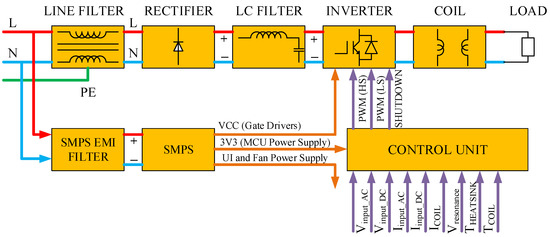
Figure 1.
Basic building block of domestic induction heating systems.
Meanwhile, there are some criteria that define the performance of an induction cooktop. High zone power ratings, high performance, total height of the product, and silence are the most prominent ones. These criteria are directly related to power semiconductor switch losses. All the commercialized induction cookers have been using IGBTs for a long time. There are different types of IGBT technologies, some of which are directly produced for resonant applications. IGBTs can be preferred thanks to their low saturation voltage (), which results in low conduction loss; however, they have limited switching capacity because of the tail current they have during turn-off. Most modern induction cooktops operate between 18 kHz and 50 kHz, and their resonance frequency is between 18 kHz and 20 kHz [2,3,4].
There are different research papers about WBG power semiconductors that show that WBG power semiconductors are applied to domestic and industrial induction heating applications. WBG power semiconductors are evaluated in different power electronic systems and compared with Si-based designs in [5], while Si-based switches are compared with WBG power switches in [6]. There is also a variety of research that is directly related to induction cookers. Si IGBT, GaN HEMT (Gallium Nitride High Electron Mobility Transistor), and SiC MOSFET (Silicon Carbide Metal Oxide Semiconductor Field Effect Transistor) are compared in [7] for a 2.0 kW power rating. Refs. [8,9] compared SiC MOSFET and SiC JFET (Junction Field Effect Transistor) in terms of power losses. In these works, power ratings range from 200 W to 1800 W, while switching frequencies change between 45 kHz and 125 kHz. Ref. [10] compares normally-on SiC JFET and Si IGBT in a series resonant half-bridge converter at 2.4 kW power rating up to 500 kHz switching frequency. All SiC power semiconductor technologies are tested and evaluated for induction cookers in [11]. Normally-on and normally-off SiC JFETs, SiC BJT (Bipolar Junction Transistor), and SiC MOSFETs are tested and compared from different perspectives. SiC BJT power switches are evaluated for a new ZCS (Zero Current Switching) converter in [12,13]. Although most of the research focuses on series-resonant half-bridge converters, there are also papers related to single-ended quasi-resonant converters. Refs. [14,15,16] apply SiC power switches to single-switch resonant converters. WBG devices enable us to configure induction cooktops in different ways, which are hard to design with Si-based power semiconductors. Refs. [17,18,19] use GaN HEMT power switches and design full-flexi high-segment induction cooktops. Ref. [17] uses GaN HEMT in 2 MHz switching frequency and loads power up to 15 A. It also considers thermal perspective and layout design. Ref. [18] elaborates on full-flexi induction cookers. It simulates 800 W load power for different switching frequencies ranging from 100 kHz to 500 kHz. Ref. [19] implements GIT (Gate Injected Transistor) GaN HEMT technology in induction cookers at 2.2 kW power and 50 kHz–100 kHz switching frequencies.
A series resonant half-bridge converter is evaluated at different operating conditions. Measurements are inspired by real induction cooker operating conditions. The power rating is increased up to 3.7 kW, while the switching frequency ranges from 20 kHz to 100 kHz. Apart from traditional 4-zone induction cookers, high-segment full-flexi induction cookers are also elaborated in detail. To show the benefits of WBG device performance, WBG power devices under power ratings range from 0.3 kW to 1 kW while switching frequencies range from 265 kHz to 1 MHz.
The objectives of this research can be summarized as follows:
- The proper power semiconductor selection criteria for domestic induction cooktops are examined.
- The benefits of using WBG in domestic induction under different operations in comparison with Si-based IGBT are examined.
- The power losses are analyzed for each specific working condition. Thermal and electrical measurements are taken.
- The proper conditions to switch from Si-based conventional design to WBG-based state-of-the-art design are researched.
2. Power Semiconductor Selection for Series Resonant Half-Bridge Converter
2.1. Operating Conditions for Series Resonant Half-Bridge Converter
To determine the performance of a power semiconductor, there are two significant operating conditions in an induction cooktop: In operation 1, the power converter is working at its maximum load power and minimum switching frequency, whereas in operation 2, it is working at a lower load power and a higher switching frequency. In this section, these operating conditions are analyzed in detail to determine the proper power semiconductor selection.
2.1.1. Operating Condition 1: Maximum Load Power—Minimum Switching Frequency
Condition 1 is the maximum load power condition where the switching frequency is so close to the resonant frequency, thus switching losses are mostly dominated by conduction losses. As can be seen from the waveforms in Figure 2a,b, the turn-off current is nearly zero, thus switching losses are negligible. Because of the snubber capacitors, the diode region does not occur. As a result, total loss is mostly dominated by conduction loss.
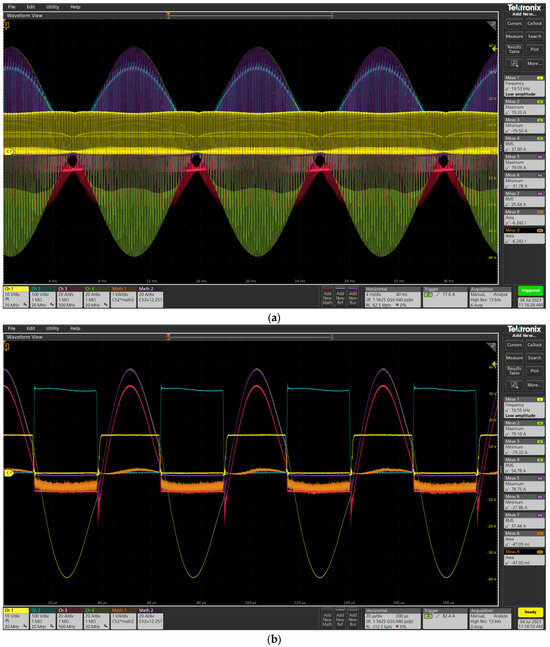
Figure 2.
Operating condition-1 waveforms: (a) 4 ms/div; (b) 20 µs/div. Yellow waveform: gate drive signal, blue waveform: IGBT VCE voltage, red waveform: IGBT IC current measured by Rogowski coil, green waveform: induction coil current, purple waveform (math2): IGBT current without Rogowski offset, orange waveform: IGBT power loss.
2.1.2. Operating Condition 2: Lower Load Power—Higher Switching Frequency
In this condition, the switching frequency is increased to reduce load power. When the load power is decreased, the load current decreases; therefore, conduction loss will be lower than in Operating Condition 1. Switching losses are higher than in Operating Condition 1 because of increased frequency and a higher turn-off current. The diode region occurs obviously due to the operation in the inductive region. Waveforms are shown in Figure 3a,b. The power losses are dominated by conduction losses; however, switching and diode losses are also effective on converter performance.
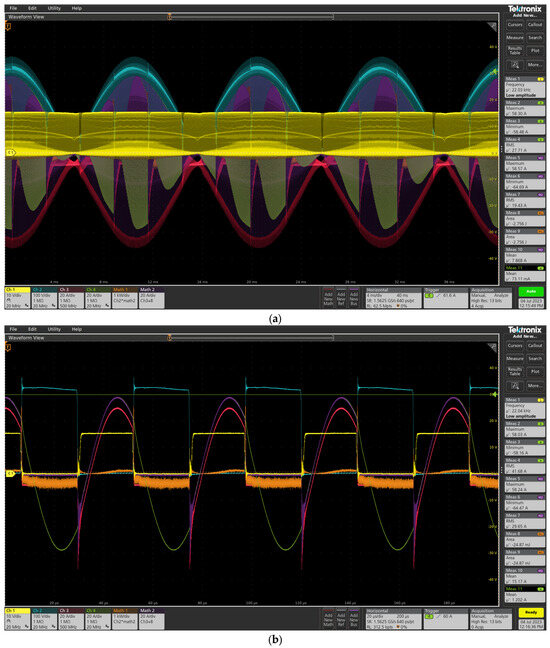
Figure 3.
Operating condition-2 waveforms: (a) 4 ms/div; (b) 20 µs/div. Yellow waveform: gate drive signal, blue waveform: IGBT VCE voltage, red waveform: IGBT IC current measured by Rogowski coil, green waveform: induction coil current, purple waveform (math2): IGBT current without Rogowski offset, orange waveform: IGBT power loss.
The major electrical parameters for the two operating conditions are listed in Table 1.

Table 1.
Operating conditions fundamental parameters.
2.2. Si-Based Power Semiconductor Selection
Modern induction cookers prefer Si-based IGBTs thanks to their low saturation voltages () and moderate switching capacities, which are limited due to tail current phenomena occurring during turn-off. As can be seen from the operating conditions explained in the previous sections, conduction loss is one of the most important factors affecting total losses. That is the reason IGBTs are preferred in this application. There are plenty of manufacturers that produce Si-based IGBTs for half-bridge converters. 600–650 V and 40–50 A IGBTs are mostly used in series resonant half-bridge converters. This section tries to find out the most suitable IGBT by comparing their performances with selected WBG devices.
The datasheet parameters are used preliminarily to compare IGBTs. The first parameter is the saturation voltage. Figure 4a,b show saturation voltages of IGBTs for different junction temperatures. The second parameter is the diode forward voltage. Figure 5a,b show forward voltage drops for different junction temperatures. As mentioned above, conduction loss is the major contributor to total switch loss. Therefore, is the most crucial parameter to determine IGBT.
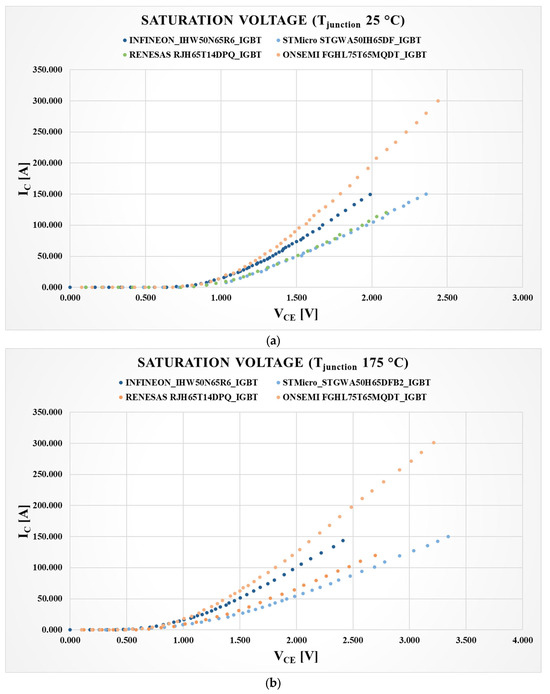
Figure 4.
IGBT saturation voltages at different junction temperatures: (a) IGBT voltages at 25 C junction temperature; (b) IGBT voltages at 175 C junction temperature.
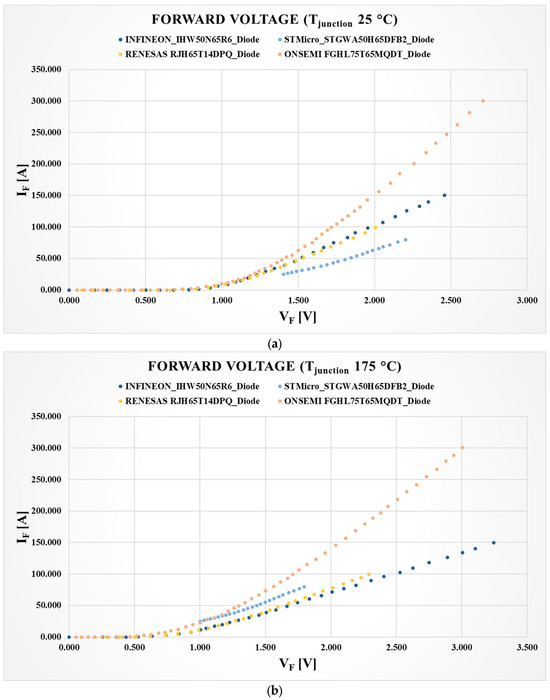
Figure 5.
Diode voltages at different junction temperatures: (a) Diode voltages at 25 C junction temperature; (b) Diode voltages at 175 C junction temperature.
When characteristics are compared at different junction temperatures, Infineon’s IHW50N65R6 and Onsemi’s FGHL75T65MQDT IGBTs are suitable for high-power applications. However, IHW50N65R6 is selected for comparison with the WBG devices since this IGBT is specifically produced for induction heating applications and is preferable both in terms of cost and technical specifications. When comparing characteristics that are at different junction temperatures, IHW50N65R6 is not the best option to choose; however, diode conduction loss is a small portion of the total conduction losses, hence making IHW5065R6 the best selection for this application. IHW50N65R6 has Reverse Conduction IGBT (RC IGBT) technology, which integrates the body diode into the IGBT die so it only uses one die. This is advantageous in terms of manufacturing, cost, packaging, and EMI.
2.3. WBG-Based Power Semiconductors Selection
Wide-band gap power semiconductors have been popular for modern power electronics applications such as EV (Electrical Vehicle) charges, renewable energy systems, traction inverters, PFC (Power Factor Correction) circuits, and motor drivers. While the requirements of modern systems have been getting more challenging, Si-based power semiconductors, which are already within their theoretical limits, are not able to live up to those demands. The advantageous characteristics of wide band gap power semiconductors, such as high PCB (Printed Circuit Board) density, lack of bulky heatsinks, and cooling fans, are just a few of them. As Si-based power semiconductors get closer to their theoretical limits, new searches focus on wide band gap semiconductors. Table 2 compares the basic chemical characteristics of Si and WBG semiconductors.

Table 2.
Semiconductor Material Comparison.
In series resonant half-bridge converters, the maximum voltage stress of power switches is 325 V. Therefore, a power semiconductor whose voltage rating is 650 V can be selected. To compare with Si-based power semiconductors, GS66516B from GaN Systems is selected in order to examine the usage of WBG power semiconductors in domestic induction heating applications. It can switch on and off at tremendous speeds that Si-based devices cannot reach. Its voltage strength is 650 V, which is very well suited for grid-connected series resonant half-bridge converters. The electrical characteristics of selected power semiconductors are shown in Figure 6a–c.
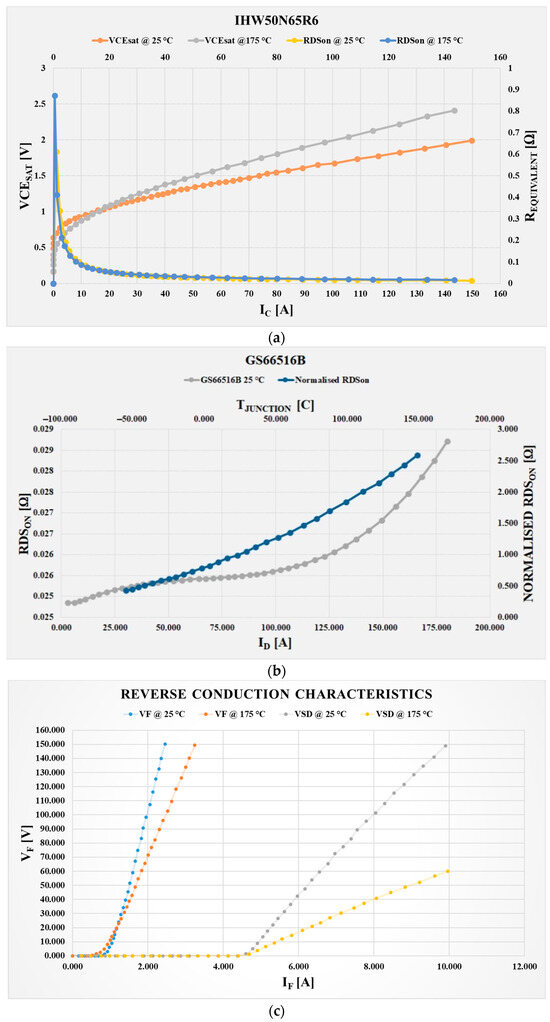
Figure 6.
Characteristics of selected power semiconductors for domestic induction heating application: (a) IHW50N65R6 IGBT characteristics for different junction temperatures; (b) GS66516B characteristics for different junction temperatures; (c) Reverse conduction characteristics for both.
3. Experimental Results
The WBG power device is tested at different operating conditions to find out the optimum operating conditions to use WBG power semiconductors properly. First, the WBG power semiconductors are operated in conventional domestic induction cooking conditions and analyzed at high power and low switching frequencies. Secondly, WBG power semiconductors are analyzed by operating at high switching frequencies with the same zone powers as conventional induction cooktops. Finally, WBG power semiconductors operate in high-segment full-flexi induction cooktops and are analyzed for different switching frequencies and powers. At the end of the measurement results, advantages and disadvantages are listed. When and how to use this new generation of power semiconductors in domestic induction cooktops is elaborated in detail. Figure 7 shows the roadmap for how to integrate WBG devices into domestic induction cooktops.
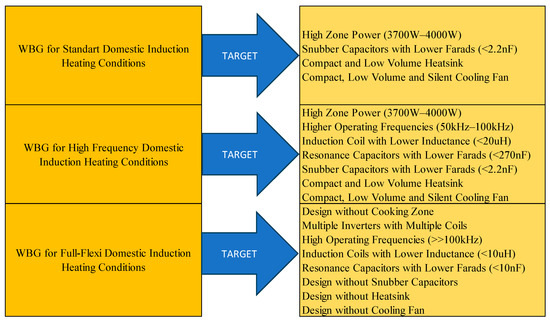
Figure 7.
Roadmap to use WBG power semiconductors in domestic induction heating applications.
GaN Systems GSP65RxxHB-EVB is chosen to compare the WBG power semiconductor with the Si-based IGBT. This board is specifically designed for high-power applications; hence, it contains two GS66516B GaN HEMTs in parallel. Its PCB structure is designed as an IMS (Insulated Material Board). The power stages are shown in Figure 8a–c.
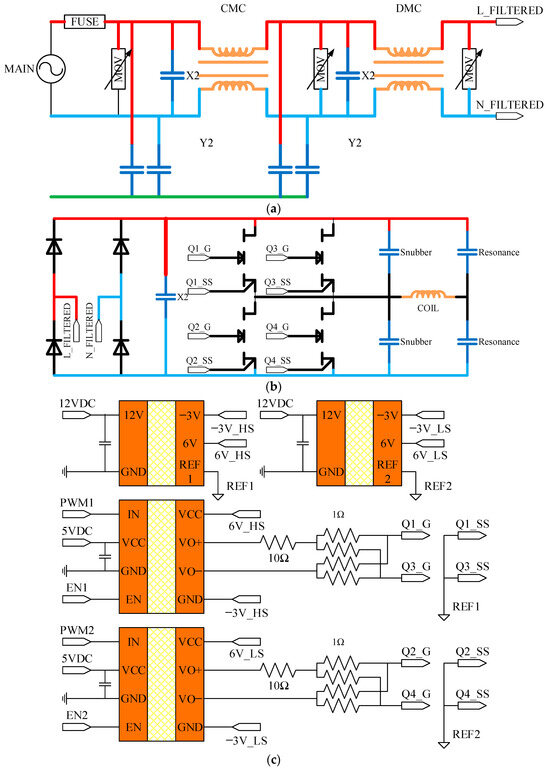
Figure 8.
Power sections are used in measurements. (a) Line filter; (b) Resonance Converter; (c) Gate driver circuitry block diagram.
While all thermal measurements are taken with Fluke Ti480, all oscilloscope measurements are taken by TELEDYNE Lecroy HDO6054. To prevent power devices from a thermal runaway, a cooling fan is used. While its rated voltage is 12 V DC, it is used in a 5 V DC condition.
3.1. Si-Based IGBT in Conventional Induction Cooking Operation
In this section, the selected IHW50N65R6 (Infineon) is tested in conventional induction cooking operations. While oscilloscope measurements are shown in Figure 9a,b thermal measurements are shown in Figure 10a,b. Power circuit parameters and power losses are shown in Table 3 and Table 4, respectively.
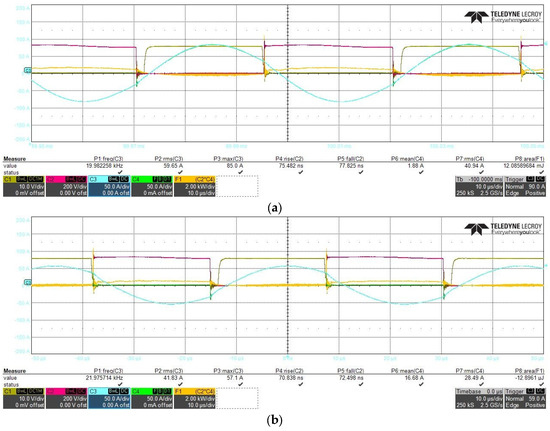
Figure 9.
IHW50N65R6 oscilloscope measurements at conventional induction cooking operations: (a) Operating condition−1 waveforms; (b) Operating condition−2 waveforms. Yellow (CH1) and red (CH2) waveforms are low and high side IGBT VCE voltages, respectively; blue waveform (CH3) is coil current; green waveform (CH4) is high side IGBT current; orange waveform (MATH2) is high side IGBT power loss.
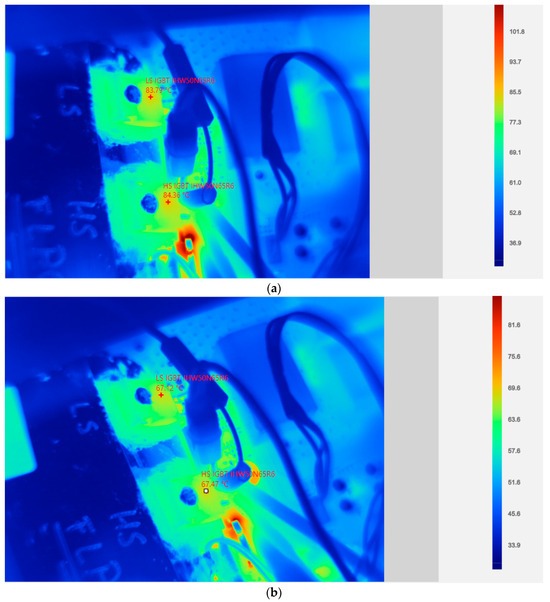
Figure 10.
IHW50N65R6 thermal measurements at conventional induction cooking operation: (a) Thermal measurements of operating condition 1; (b) Thermal measurements of operating condition 2.

Table 3.
Power circuit parameters for conventional induction cooking (IHW50N65R6).

Table 4.
Power losses for conventional induction cooking operation (IHW50N65R6).
This IGBT is one of the best IGBTs that could be used in domestic induction cooking applications. Therefore, these thermal measurements and power losses refer to WBG power semiconductor measurements.
3.2. WBG Device in Conventional Induction Cooking Operation
In this section, the selected GS66516B is tested in conventional induction cooking operations. While the oscilloscope measurements are shown in Figure 11a,b, thermal measurements are shown in Figure 12a,b. The power circuit parameters and power losses are shown in Table 5 and Table 6, respectively.
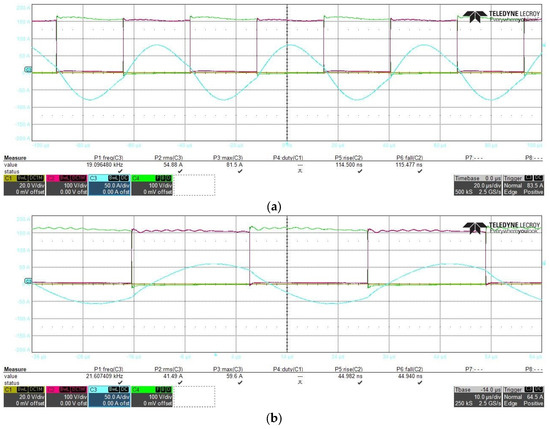
Figure 11.
GS66516B oscilloscope measurements at conventional induction cooking operation: (a) Operating condition 1 waveforms. (b) Operating condition 2 waveforms. Red (CH2) and green (CH4) waveforms are low and high side HEMTs VDS voltages, respectively; blue (CH3) waveform is coil current.
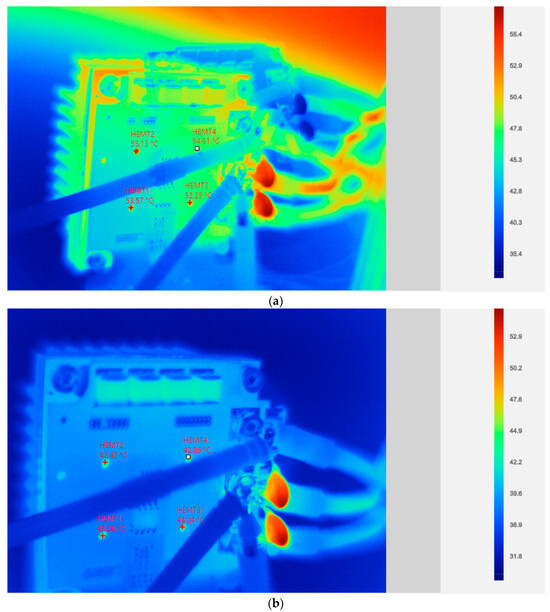
Figure 12.
GS66516B thermal measurements at conventional induction cooking operation: (a) Thermal measurements of operating condition 1; (b) Thermal measurements of operating condition 2.

Table 5.
Power circuit parameters for conventional induction cooking operation (GS66516B).

Table 6.
Power losses for conventional induction cooking operation (GS66516B).
3.3. WBG for High-Frequency Induction Cooking Conditions
As mentioned in the previous sections, the WBG power semiconductor enables us to increase switching frequency due to its superior switching performance. In this section, the WBG device is tested at a high switching frequency without sacrificing power ratings. While the oscilloscope measurements are shown in Figure 13a,b, thermal measurements are shown in Figure 14a,b. The power circuit parameters and power losses are shown in Table 7 and Table 8, respectively.
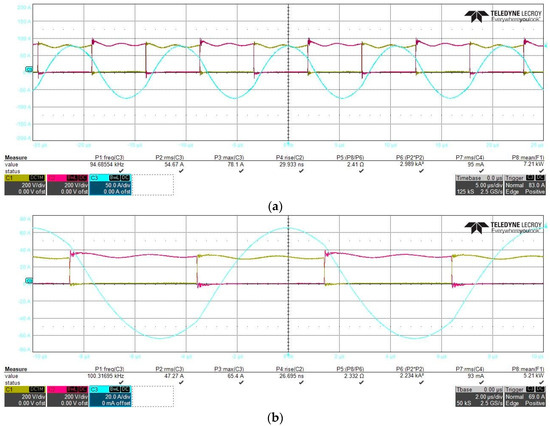
Figure 13.
GS66516B oscilloscope measurements at high-frequency induction cooking operation: (a) Operating condition 1 waveforms; (b) Operating condition 2 waveforms. Yellow (CH1) and red (CH2) waveforms are low and high side HEMTs VDS voltages respectively, blue (CH3) waveform is coil current.
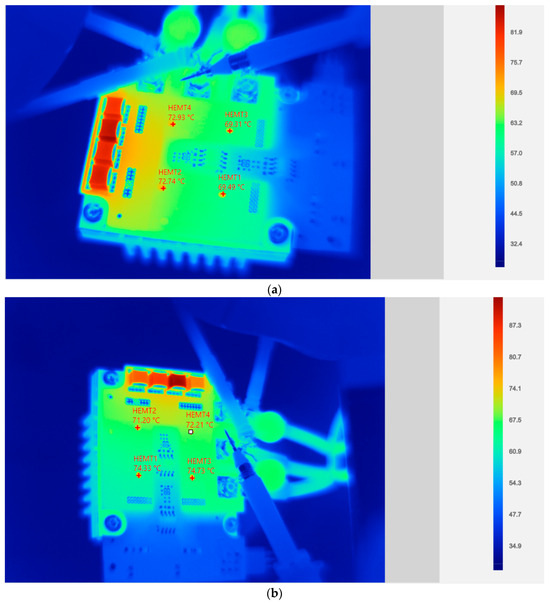
Figure 14.
GS66516B thermal measurements at high-frequency induction cooking operation: (a) Thermal measurements of operating condition 1; (b) Thermal measurements of operating condition 2.

Table 7.
Power circuit parameters for high-frequency induction cooking operation (GS66516B).

Table 8.
Power losses for high-frequency induction cooking operations (GS66516B).
3.4. WBG for All Metal Induction Cooking Operation
Most domestic induction cooktops need ferromagnetic pans to heat up. They cannot heat non-ferromagnetic materials such as copper and aluminum because of their low equivalent resistance () and inductance (). To transfer high power ratings (above 2.3 kW) to non-ferromagnetic pans with modern induction cooktops, coil and switch current ratings increase to levels that Si-based power semiconductors are not able to withstand. These types of pans can be heated up to high power levels by increasing the switching frequency to increase the equivalent series resistance. WBG power semiconductors can be used in this type of application to increase switching frequency to heat non-ferromagnetic materials [20]. While oscilloscope measurements are shown in Figure 15a,b, thermal measurements are shown in Figure 16a,b. The power circuit parameters and power losses are shown in Table 9 and Table 10, respectively.

Figure 15.
GS66516B oscilloscope measurements at all-metal induction cooking operation: (a) Operating condition 1 waveforms; (b) Operating condition 2 waveforms. Yellow (CH1) and red (CH2) waveforms are low and high side HEMTs VDS voltages, respectively; blue (CH3) waveform is coil current.
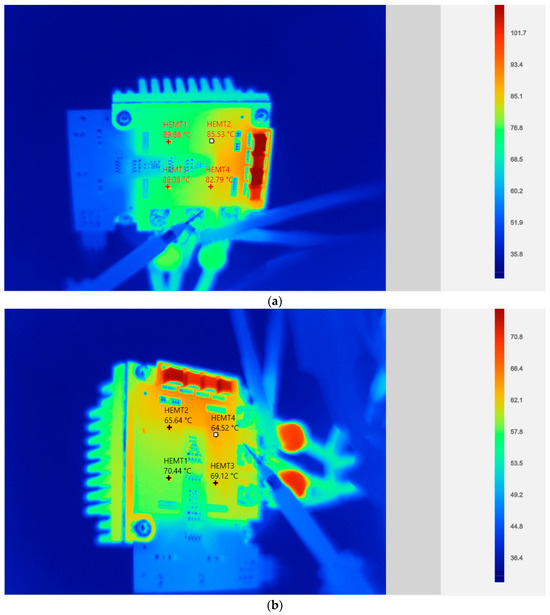
Figure 16.
GS66516B thermal measurements at all-metal induction cooking operation: (a) Thermal measurements of operating condition 1; (b) Thermal measurements of operating condition 2.

Table 9.
Power circuit parameters for all-metal induction cooking operation (GS66516B).

Table 10.
Power losses for all-metal induction cooking operations (GS66516B).
3.5. WBG for Full-Flexi Operation
The flexi induction cooktops are high-segment induction cookers that can heat every section of the hob without specific zones. These types of cooktops consist of multiple inverters and induction coils with low power ratings. In this section, operating conditions that could be used in flexi applications are covered. Figure 14 shows waveforms at different operating conditions. The thermal measurements are shown in Figure 15. All power losses and operating conditions are shown in Figure 16. While the oscilloscope measurements are shown in Figure 17a–e, thermal measurements are shown in Figure 18a–e. The power circuit parameters and power losses are shown in Table 11 and Table 12, respectively.
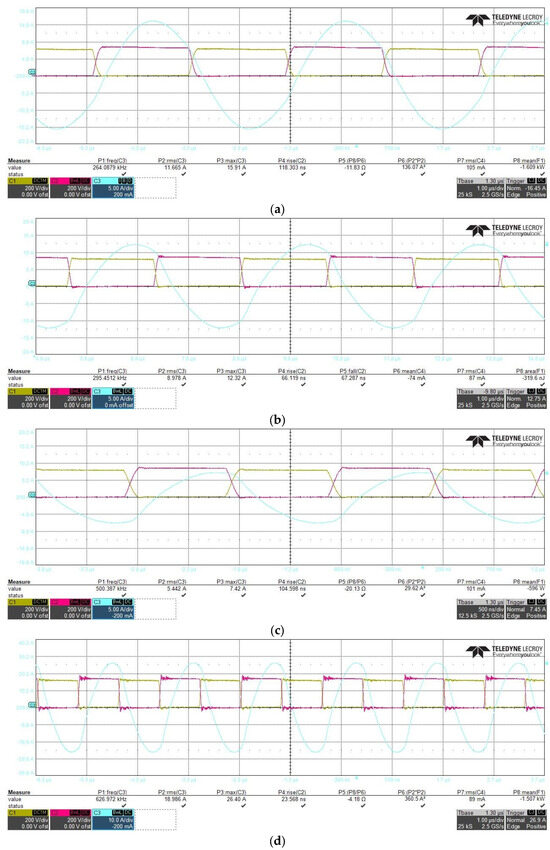

Figure 17.
GS66516B oscilloscope measurements at full-flexi induction cooking operation (a) Operating condition 1 waveforms; (b) Operating condition 2 waveforms; (c) Operating condition 3 waveforms; (d) Operating condition 4 waveforms; (e) Operating condition 5 waveforms. Yellow (CH1) and red (CH2) waveforms are low and high side HEMTs VDS voltages, respectively; blue (CH3) waveform is coil current.
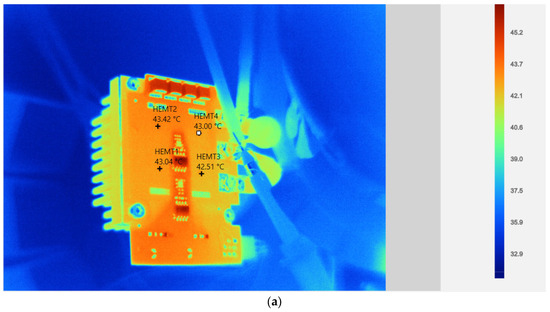
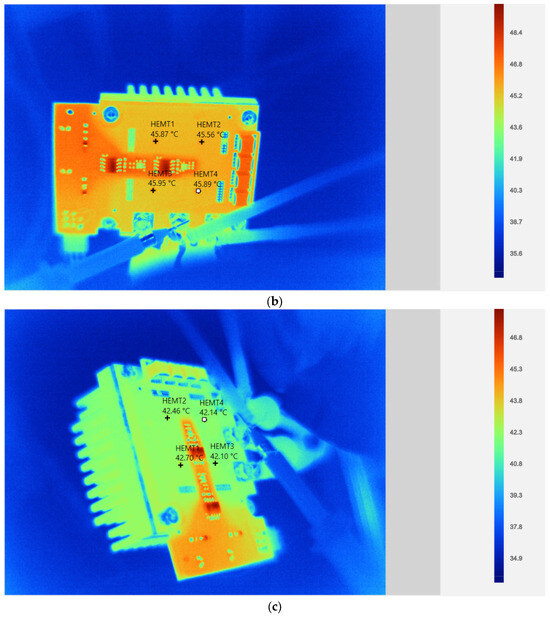
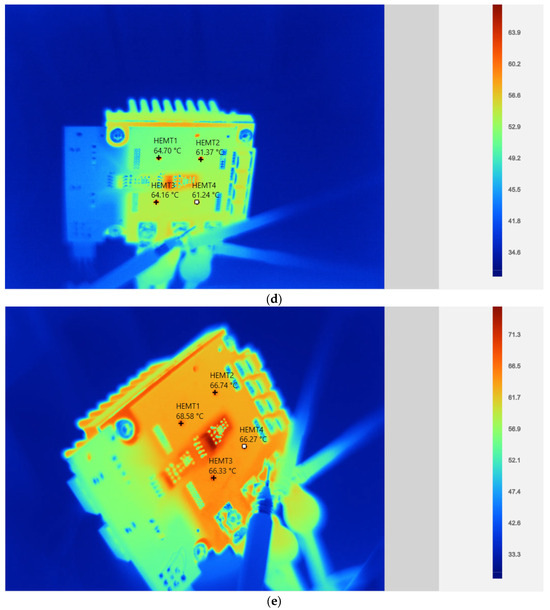
Figure 18.
GS66516B thermal measurements at full-flexi induction cooking operation: (a) Operating condition 1; (b) Operating condition 2; (c) Operating condition 3; (d) Operating condition 4; (e) Operating condition 5.

Table 11.
Power circuit parameters for full-flexi induction cooking operations (GS66516B).

Table 12.
Power losses for full-flexi induction cooking operations (GS66516B).
4. Discussion
In this study, the application of WBG power semiconductors in domestic induction cookers is investigated. WBG power switches have been tested under different working conditions. All measurements are summarized in Table 13. The results of the studies show that WBG switches have very reasonable conduction characteristics compared to their Si counterparts. Measurement results are shown in Figure 19. Conduction losses are quite dominant in domestic induction heating topologies, so a much better conduction characteristic can be achieved by connecting two or more switches in parallel. Thus, much better product performance can be achieved. Increasing the operating frequency to very high levels compared to conventional operating conditions makes the switching characteristics more important. As can be seen from Figure 20, the WBG semiconductor shows many times better switching characteristics. Therefore, it is much easier to reach high switching frequencies than Si-based IGBTs. With a suitable coil design, performance improvement can be achieved by minimizing switching losses, especially at high frequencies. Coil design is beyond the scope of this study. In the case of full-flexi operation, very high switching frequencies make reverse conduction losses much more important. Measurement results are shown in Figure 21. The reverse-conduction characteristics of WBG switches are poor. Therefore, the reverse conduction region should be kept very short so that the current flows through the channel. In this way, losses can be additionally minimized. With an appropriate coil design, the duration of the free-wheeling region can be further minimized.

Table 13.
All measurements result.
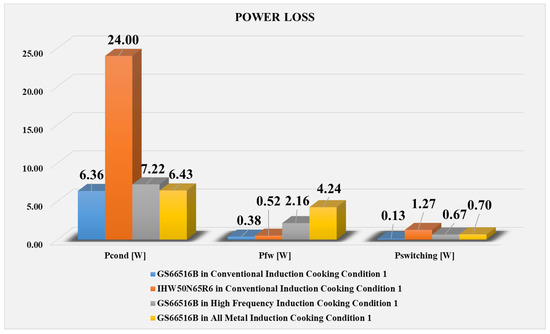
Figure 19.
All condition 1 measurements.
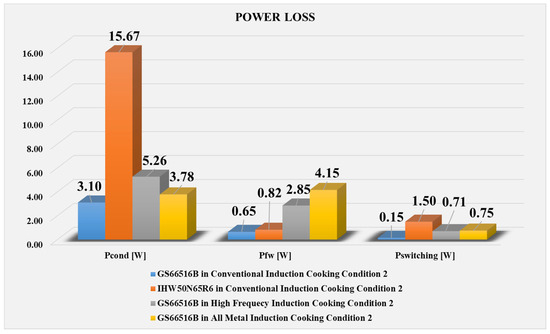
Figure 20.
All condition 2 measurements.
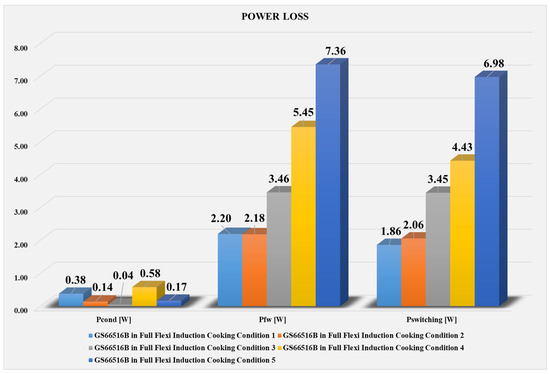
Figure 21.
All full-flexi measurements.
5. Conclusions
In this study, the optimal use of WBG power devices in domestic induction heating applications is examined. GaN HEMT is tested for different operating conditions to find optimum operating conditions and tried to answer “When it makes sense to switch Si-based IGBTs to WBG power semiconductors”. The first step is to use WBG power semiconductors in conventional domestic induction heating conditions. In this condition, the power rating is high and the switching frequency is low; therefore, the main contributor to total power loss is conduction loss. A WBG power semiconductor whose on-state resistance is so low that its conduction loss is well below Si-based IGBTs can outperform. However, a discrete power semiconductor with lower on-state resistance than IGBT can cost too much. Using two or more switches in parallel is another solution, but this is not cost-effective either. Potential EMI problems are another issue to deal with because of the high dv/dt and di/dt ratings. As a result, the fact that a WBG power semi-conductor operates in standard domestic induction heating conditions does not make sense in terms of the total product.
The second step is to use WBG power semiconductors in high-frequency applications with the same zone power as conventional cooktops, thanks to their superior switching performance. In this condition, we can reduce the size of passive components considerably. As a result of this, more efficient power conversion, and a slim, low-noise design can be achievable. The decreasing number of turns in induction coils and capacitors with low ESR (Equivalent Series Resistance) values contributes to total efficiency. The cost of WBG power devices can be met by other design parameters, such as passive components with lower values, heatsinks with low volumes, cooling fans with low power, and induction coils with a lower number of turns. High-frequency operation can also be effective in heating non-ferromagnetic materials such as aluminum and copper. These types of pans can be heated without complex induction coil and power converter designs due to their high operating frequencies. As a result, the usage of WBG power semiconductors in high-frequency and power conditions makes sense.
The other operating condition is the flexi induction cooktop design with WBG power devices. Flexi cooktops can heat a pan anywhere on the glass. They use multi-inverters structure with multiple induction coils to achieve this type of design. WBG power devices, specifically GaN HEMT, can be suitable for these designs because they can switch at very high speeds. Ultra-high switching speeds can also enable planar magnetics, which is also an important advantage for increasing power density. Low power loss due to the superior characteristics of GaN HEMT could enable to design without a heatsink and a cooling fan.
Author Contributions
Conceptualization, A.E. and A.H.O.; methodology, A.E. and A.H.O.; validation, A.E. and A.H.O.; investigation, A.E. and A.H.O.; writing—original draft preparation, A.E. and A.H.O.; writing—review and editing, A.E. and A.H.O. All authors have read and agreed to the published version of the manuscript.
Funding
This research received no external funding.
Institutional Review Board Statement
Not applicable.
Informed Consent Statement
Not applicable.
Data Availability Statement
Publicly available datasets were analyzed in this study. This data can be found here: https://www.infineon.com/dgdl/Infineon-IHW50N65R6-DataSheet-v01_20-EN.pdf?fileId=5546d46277fc7439017826e1c8ed727b (accessed on 15 October 2023), https://www.st.com/resource/en/datasheet/stgwa50h65dfb2.pdf (accessed on accessed on 15 October 2023), https://www.renesas.com/us/en/document/dst/rjh65t14dpq-a0-data-sheet?r=515866 (accessed on accessed on 15 October 2023), https://www.onsemi.com/download/data-sheet/pdf/fghl75t65mqdt-d.pdf (accessed on accessed on 15 October 2023), https://gansystems.com/wp-content/uploads/2021/12/GS66516B-DS-Rev-211025.pdf (accessed on accessed on 15 October 2023).
Acknowledgments
This work was supported by Arcelik A. Ş. Research and Development Center.
Conflicts of Interest
The authors declare no conflict of interest.
Nomenclature
| IGBT saturation voltage | Switching frequency | ||
| IGBT collector current | Equivalent resistance | ||
| Diode forward voltage | Equivalent inductance | ||
| Diode current | Resonance capacitors | ||
| GaN HEMT On-state resistance | Snubber Capacitors | ||
| GaN HEMT Drain current | Dead time | ||
| GaN HEMT Reverse voltage drop | Conduction loss | ||
| The rate of change of current | Switching loss | ||
| The rate of change of voltage | Reverse conduction loss | ||
| Input power |
References
- Lucia, O.; Maussion, P.; Dede, E.J.; Burdio, J.M. Induction heating technology and its applications: Past developments, current technology, and future challenges. IEEE Trans. Ind. Electron. 2014, 61, 2509–2520. [Google Scholar] [CrossRef]
- ONSEMI Corporation. Induction Cooking Appl. Notes. 2014. Available online: https://www.onsemi.com/pub/Collateral/AND9166-D.PDF (accessed on 1 October 2014).
- Infineon. Reverse-Conducting IGBTs for Induction Cooking and Resonant Applications. Appl. Notes. 2021. Available online: https://www.infineon.com/dgdl/Infineon-AN2014_01_Reverse_Conducting_IGBT-ApplicationNotes-v03_01-EN.pdf?fileId=db3a30434441da19014445a1e7560135 (accessed on 24 August 2021).
- Abbatelli, L.; Catalisano, G.; Gulino, R.; Melito, M. Induction cooking: IGBTs in resonant converters ST microelectronics Appl. Note. 2015. Available online: https://www.st.com/resource/en/application_note/an4713-induction-cooking--igbts-in-resonant-converters-stmicroelectronics.pdf (accessed on 3 June 2015).
- Kumar, A.; Moradpour, M.; Losito, M.; Franke, W.-T.; Ramasamy, S.; Baccoli, R.; Gatto, G. Wide Band Gap Devices and Their Application in Power Electronics. Energies 2022, 15, 9172. [Google Scholar] [CrossRef]
- Prado, E.O.; Bolsi, P.C.; Sartori, H.C.; Pinheiro, J.R. An Overview about Si, Superjunction, SiC and GaN Power MOSFET Technologies in Power Electronics Applications. Energies 2022, 15, 5244. [Google Scholar] [CrossRef]
- Cha, K.-H.; Ju, C.-T.; Kim, R.-Y. Analysis and Evaluation of WBG Power Device in High Frequency Induction Heating Application. Energies 2020, 13, 5351. [Google Scholar] [CrossRef]
- Aslan, S.; Ozturk, M.; Altintas, N. A Comparative Evaluation of Wide-Bandgap Semiconductors for High-Performance Domestic Induction Heating. Energies 2023, 16, 3987. [Google Scholar] [CrossRef]
- Aslan, S.; Ozturk, M.; Altintas, N. A comparative study of SiC and Si power devices in induction cookers. In Proceedings of the 5th International Conference on Electrical and Electronics Engineering (ICEEE 2018), Istanbul, Turkey, 3–5 May 2018; pp. 297–301. [Google Scholar] [CrossRef]
- Bernal, C.; Molina Gaudó, P.; Gállego, A.; Otín, A.; Burdío, J.M. Half-bridge resonant inverter for domestic induction heating based on silicon carbide technology. In Proceedings of the IEEE Applied Power Electronics Conference and Exposition, (APEC), Orlando, FL, USA, 5–9 February 2012; pp. 2218–2222. [Google Scholar] [CrossRef]
- Sarnago, H.; Lucía, O.; Burdío, J.M. A Comparative Evaluation of SiC Power Devices for High-Performance Domestic Induction Heating. IEEE Trans. Ind. Electron. 2015, 62, 4795–4804. [Google Scholar] [CrossRef]
- Sarnago, H.; Lucía, O.; Mediano, A.; Burdío, J.M. SiC BJT-based full-ZCS quasi-resonant converter with improved efficiency for induction heating applications. In Proceedings of the IEEE Applied Power Electronics Conference and Exposition (APEC), Fort Worth, TX, USA, 16–20 March 2014; pp. 852–856. [Google Scholar] [CrossRef]
- Sarnago, H.; Lucia, O.; Mediano, A.; Burdio, J.M. Improved operation of SiC-BJT-based series resonant inverter with optimized base drive. IEEE Trans. Power Electron. 2014, 29, 5097–5101. [Google Scholar] [CrossRef]
- Mangkalajarn, S.; Ekkaravarodome, C.; Sukanna, S.; Bilsalam, A.; Jirasereeamongkul, K.; Higuchi, K. Comparative Study of Si IGBT and SiC MOSFET in Optimal Operation Class-E Inverter for Domestic Induction Cooker. In Proceedings of the Research, Invention, and Innovation Congress (RI2C), Bangkok, Thailand, 11–13 December 2019; pp. 1–4. [Google Scholar] [CrossRef]
- Gaudó, P.M.; Bernal, C.; Otín, A.; Burdío, J.M. Silicon carbide JFET resonant inverter for induction heating home appliances. In Proceedings of the 37th Annual Conference of the IEEE Industrial Electronics Society, Melbourne, VIC, Australia, 7–10 November 2011; pp. 2551–2556. [Google Scholar] [CrossRef]
- Bernal, C.; Avellaned, J.; Leon, J.; Molina, P. SiC single switch resonant inverters performance dependence on induction load. In Proceedings of the 2014 16th European Conference on Power Electronics and Applications, (EPE-ECCE Europe 2014), Lappeenranta, Finland, 26–28 August 2014. [Google Scholar] [CrossRef]
- Sarnago, H.; Burdío, J.M.; Lucia, O. High-Frequency GaN-Based Induction Heating Versatile Module for Flexible Cooking Surfaces. In Proceedings of the IEEE Applied Power Electronics Conference and Exposition (APEC), Anaheim, CA, USA, 17–21 March 2019; pp. 448–452. [Google Scholar] [CrossRef]
- Kwon, M.J.; Jang, E.; Park, S.M.; Kuk Lee, B. Design and Optimization of GaN-HEMT Based Inverter-Coil Integrated Module for Flexible Cooking Surface Induction Cooktop. In Proceedings of the 23rd International Conference on Electrical Machines and Systems (ICEMS 2020), Mamamatsu, Japan, 24–27 November 2020; pp. 331–336. [Google Scholar] [CrossRef]
- Sarnago, H.; Lucia, O.; Burdío, J.M. Advanced induction heating appliances using high-voltage GaN gate injection transistors. In Proceedings of the IEEE Applied Power Electronics Conference and Exposition (APEC), Charlotte, NC, USA, 15–19 March 2015; pp. 1375–1380. [Google Scholar] [CrossRef]
- Jang, E.; Park, S.M.; Joo, D.; Ahn, H.M.; Lee, B.K. Feasibility Study on All Metal Induction Cooker Systems Considering Topology and Control. In Proceedings of the 2018 IEEE Energy Conversion Congress and Exposition (ECCE), Portland, OR, USA, 23–27 September 2018; pp. 936–941. [Google Scholar] [CrossRef]
Disclaimer/Publisher’s Note: The statements, opinions and data contained in all publications are solely those of the individual author(s) and contributor(s) and not of MDPI and/or the editor(s). MDPI and/or the editor(s) disclaim responsibility for any injury to people or property resulting from any ideas, methods, instructions or products referred to in the content. |
© 2023 by the authors. Licensee MDPI, Basel, Switzerland. This article is an open access article distributed under the terms and conditions of the Creative Commons Attribution (CC BY) license (https://creativecommons.org/licenses/by/4.0/).